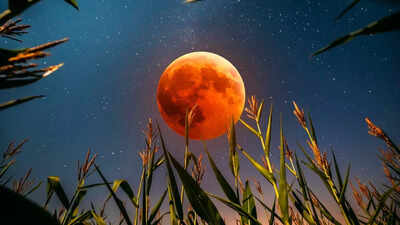ARTICLE AD BOX

Get ready to gaze upward in awe this September!On the evening of September 7 this year, skywatchers around much of the world will witness something truly spectacular: the Corn Moon.
This glowing full moon will also shine as a "Blood Moon" during a total lunar eclipse.
The Corn Moon, a glowing farewell to summer, will grace our skies on the night of September 7, and this year, it carries an extra special magic – a rare total lunar eclipse, painting the moon a copper-red in a dramatic Blood Moon spectacle. This year, the Corn Moon takes center stage because the traditional Harvest Moon title shifts to October, making this one extra special.Whether you're a casual stargazer or astronomy enthusiast, this celestial show promises beauty, wonder, and a touch of cosmic poetry.
The Corn Moon: What is it and why the name?
The Corn Moon is the full moon that appears in September, when it isn't the Harvest Moon, which is the full moon closest to the autumn equinox. It marks the time when corn, a staple crop, was historically ready for harvest in North America. While full moons often have poetic names, the Harvest Moon is a more specific concept, and in 2025, that honor falls in October, so the September full moon earns the title Corn Moon, marking the traditional time of corn harvesting in the Northern Hemisphere.
This shift happens roughly every 2-3 years.Native American traditions profoundly influenced this naming. Tribes like the Abenaki called it the Corn Maker Moon, while the Zuni saw it as “the Moon when everything ripens and corn is harvested.” It’s a name rooted deeply in the rhythms of agriculture and gratitude.
Why the Corn Moon matters this year
This year’s Corn Moon is extra special because it coincides with a total lunar eclipse, commonly known as a Blood Moon.
This dramatic event occurs when the Earth passes between the sun and the moon, casting its shadow on the Moon, turning it a deep red or coppery color. The total phase, known as totality, will last for about 82 minutes – one of the longest in recent years.
Timings and visibility
The Corn Moon reaches full illumination around 18:08–18:10 UTC on September 7, 2025, which corresponds to roughly 2:10 p.m. EDT. Although full at this moment, the moon remains below the horizon, making moonrise at dusk the best time to observe it.
Where the eclipse (blood moon) will be visible
A dramatic twist accompanies this Corn Moon: a total lunar eclipse. Regions that will see the full Blood Moon effect include:Asia, Australia, Africa, and much of Europe, where totality will be fully visible. For those in North and South America, including India’s neighbors, the moon will have set or not yet risen when the eclipse peaks, so it will be missed directly, but can still be watched via livestreams.
When and how to see it
Peak Fullness: The Corn Moon reaches full illumination at approximately 2:09 p.m.
EDT on September 7, 2025 (around 11:09 a.m. PDT).Moonrise: The best, most visually dramatic time to view the full Corn Moon is right after sunset on the same day. As the moon climbs the eastern sky, its warm glow makes for a breathtaking sight.Eclipse Timing (in UTC):Penumbral begins: 15:28Partial eclipse: ~16:27Totality peaks: 18:11, lasting until ~19:53Ends: 20:55Viewing Tips: The best part about witnessing this celestial wonder is that no special equipment is required to observe a lunar eclipse. The phenomenon is clearly visible to the naked eye, but binoculars or a telescope can enrich the view, revealing the lunar surface's rich textures and the dramatic red shading during the eclipse.
Total Lunar eclipse July 2018: Know some facts about July 27/28 Blood Moon



.png)
.png)
.png)
















 2 hours ago
3
2 hours ago
3









 English (US) ·
English (US) ·